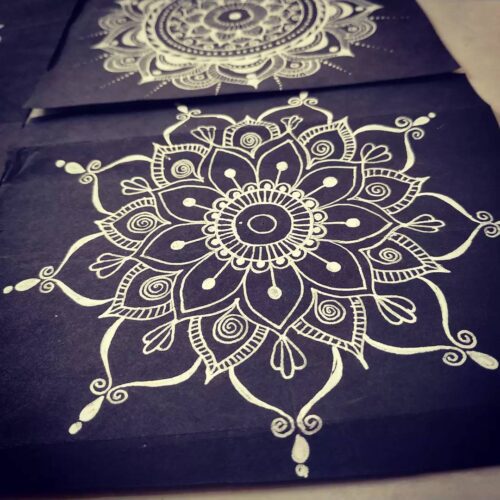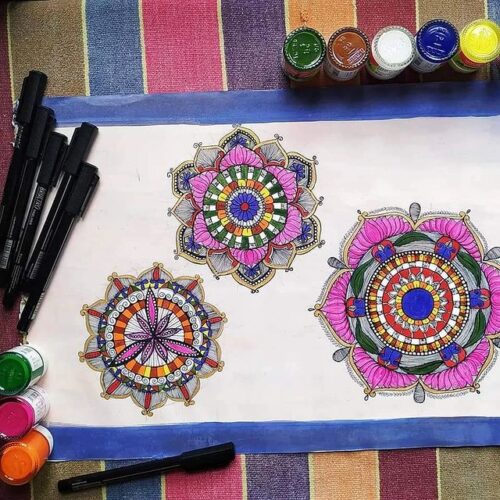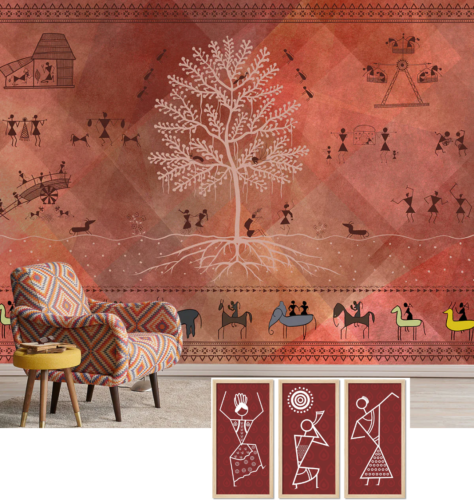Madhubani Art: Unraveling the Timeless Beauty of Bihar’s Rich Cultural Heritage
“Madhubani, the Living Tapestry of Culture, Where Colors Sing Legends, Lines Whisper Traditions, and Every Brushstroke Weaves the Timeless Threads of Heritage, Enriching Hearts with the Beauty of Mithila’s Artistic Soul.”
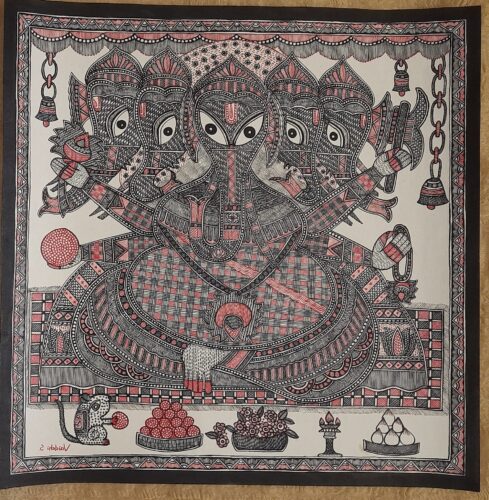
Preface
Madhubani Art, also known as Mithila Painting. It is a mesmerizing traditional art form originating from the Mithila region of Bihar, India. This art form is renowned for its vibrant colors, intricate patterns, and unique storytelling, making it a true reflection of the rich cultural heritage of Bihar.
Madhubani, the namesake of this art form, is a district in Bihar, India. The name “Madhubani” is derived from two Sanskrit words, “Madhu” meaning honey and “Ban” meaning forest. According to local legends, the region was once covered in dense forests where bees produced sweet honey, hence giving it the name “Madhubani.” The art form flourished in this region and became synonymous with it, eventually gaining recognition worldwide as Madhubani art.
The Art is just not an art for Madhubani village’s people; its a need of their everyday life. They had a strong belief that if they will draw motifs of their Gods and Deities than their home will be protected from devil and negativity. Even while they draw on floor, they have the same belief that the evil spirit is gone and Good spirits will stay.
In this article, we will explore the fascinating history, styles, creation process, significance, and global impact of Madhubani Art.
The Rich History of Madhubani Art
It is a unique and vibrant style of painting that is characterized by intricate designs and bright colors. The history of Madhubani art can be divided into several key periods:
Ancient Origins:
Madhubani art has ancient roots that can be traced back to the Ramayana and Mahabharata eras, making it over 2,500 years old. The tradition of creating intricate wall paintings, particularly during auspicious occasions and festivals, has been an integral part of the local culture for generations.
Mythological Connections:
The art form is deeply rooted in mythology and religious practices. It is believed that King Janaka, the father of Sita (the consort of Lord Rama), commissioned artists to create elaborate paintings for his daughter’s wedding, which is said to have marked the beginning of the Madhubani art tradition.
Revival and Recognition (1960s):
Despite its long history, Madhubani art remained confined to the homes and walls of rural villages for centuries. In the 1960s, it gained national and international recognition when an Indian independence activist, Jagdish Chaudhary, rediscovered it while visiting Madhubani. He encouraged local artists to paint on paper to preserve the art form and introduced it to the wider world.
Recognition as a Traditional Art Form:
With growing interest and demand, Madhubani art was recognized as one of India’s traditional art forms in the 1970s. The government’s support and initiatives helped in preserving and promoting the art among future generations.
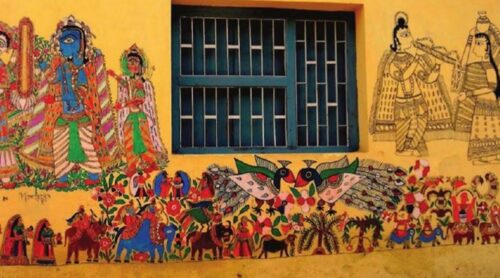
The Themes and Types of Madhubani Art
The Art is a diverse and dynamic that has evolved over time. The art that made on floor was called Aripan, for walls it was called Bhitti chitra, and Relief work for made by embossing with clay. Different types or styles of Madhubani art have emerged, each with its unique characteristics and themes.
Ritualistic Designs-Celebrating Festivals and Occasions :
The art is a daily need for people of Mithila as they use Madhubani Art as a form of celebration during festivals, Kohbar art in weddings, and other auspicious occasions. They Even make it on death by drawing an empty circle to show the emptiness.
Mithila Painting- A Cultural Tradition :
Madhubani Art, also known as Mithila Painting, has passed down through generations. Mothers have traditionally taught their daughters the knowledge and skills involved in this art form, making it an important part of women’s cultural heritage.
Impact of casticism:
As India is a place full of diversity; there have been a big impact of casticism in this art form. The art form includes contributions from three castes: Brahmins, Kayasths, and Harijans. Every cast has its own style and they made it as per they cast importance such as;
Brahmins and Kayasths painted pictures on the walls of their homes, while society did not permit Harijans to do the same. Kayasth were more educated and cultured so they draw intricate patterns and motifs using their Intelligence.
Brahmins used to make more imaginary drawings and they fill the art with more motifs. Since society restricted Harijans from using colors, they created their paintings using only mud.
Nature’s Bounty- Depicting Flora and Fauna :
Nature holds a special place in Madhubani Art, with artists beautifully portraying the flora and fauna of the region. Elements like peacocks, lotus, fish, and elephants are common motifs, reflecting the deep connection between human life and nature.
Mythological Narratives-Tales from Hindu Epics :
Madhubani Art acts as a canvas to retell various mythological stories from Hindu epics like the Ramayana, Mahabharata, and Puranas. Artists skillfully narrate these narratives through intricate designs and symbols, keeping the rich oral traditions alive.
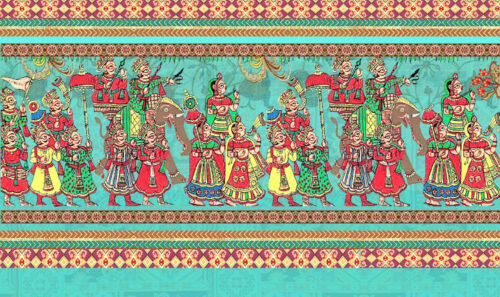
Some of the prominent types of Madhubani art include:
Kohbar Madhubani:
People in the Mithila region create Kohbar paintings for pre-wedding and post-wedding rituals. They adorn the walls of the bridal chamber with this art form, filling it with auspicious symbols and designs that represent fertility and prosperity. Also they make it on plain cloth. They wrap vermillion in it and transfer to bride to groom home and groom to bride home for every ritual.
Bhartiya Madhubani:
This style primarily focuses on depicting mythological stories and religious motifs from Hindu epics like the Ramayana and Mahabharata. The paintings often showcase scenes from the life of Lord Rama, Lord Krishna, and various deities, rendered in intricate and detailed patterns.
Kachni Madhubani:
In this style, artists use fine lines and delicate patterns to create the paintings. The themes include natural elements like flora, fauna, and geometric designs. Kachni Madhubani paintings are known for their precision and intricacy.
Tantrik Madhubani:
This style revolves around tantric symbols and representations of deities worshipped in tantric rituals. It is believed to have roots in ancient tantric practices and is characterized by its esoteric and mystical motifs.
Godna Madhubani:
Godna means “tattoo” in the local dialect. This style is inspired by the designs used in traditional tattoos and body art. The paintings feature bold and prominent lines, often depicting human figures and animals.
Bharni Madhubani:
Bharni paintings involve the use of vibrant colors to fill in the outlined figures. This style is characterized by its bold and vivid appearance, often depicting scenes from nature, festivals, and daily life.
Gobar Madhubani:
Gobar means “cow dung” in the local language. This unique style involves using a base of cow dung on the walls or canvas before applying colors. It is believed to be one of the oldest forms of Madhubani art.
Godhna Madhubani:
Godhna, meaning “hiding,” involves creating intricate patterns and motifs using hidden symbolism and abstract designs. This style leaves ample room for interpretation and personal expression.
These different types of Madhubani art showcase the rich diversity and artistic prowess of the Mithila region, where each style carries its own cultural significance and beauty.
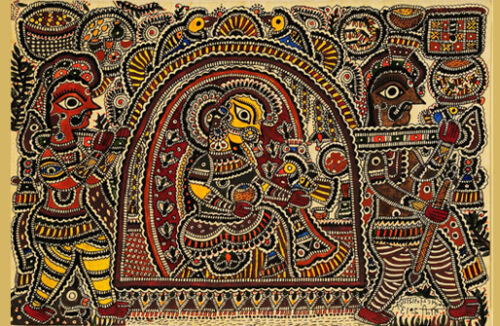
The Process of Creating Madhubani Art
The process of creating Madhubani art involves several distinct steps, each contributing to the intricate and vibrant final artwork. Here’s a general overview of the process:
Materials and Canvas:
The artist begins by gathering the necessary materials. Traditionally, Madhubani art is created on walls, floors, or cloth using natural pigments and dyes. Thin layers of clay and cow dung are used to coat the surface, serving as a protective and strengthening agent. It is considered an auspicious and prosperous messenger.
Subsequently, painted images are created using powdered rice, fingers, bamboo twigs, thread spools, and nowadays, brushes. In traditional paintings, no space is left vacant. It is filled with flowers, birds, animals, tattoo designs, etc. Nowadays, artists may also use paper or canvas as a base for their artwork. There are many kinds of colors can be used like acrylic, waterbased, oil based, color pens etc.
Outline Drawing:
The artist starts by drawing the outline of the artwork using a pencil or brush. This step establishes the basic structure and composition of the painting.
Themes and Motifs:
Madhubani art often revolves around specific themes, such as religious stories, nature, festivals, or social events. Once the outline is ready, the artist selects the appropriate motifs and designs for the chosen theme.
Filling with Colors:
After the outlines and motifs are set, the artist fills in the spaces with vibrant colors. Traditionally, Madhubani artists used natural colors obtained from flowers, leaves, spices, and other organic sources. In modern times, artists also use watercolors, acrylics, and poster colors to achieve a broader range of hues.
Women traditionally prepared colors themselves in the following manner: they used burnt barley or kohl for black; they mixed turmeric or lime for yellow; they used palash flowers for orange; safflower for red; and bael leaves for green. Today, artists use ready-made colors from the market, which leads to a rich and extensive palette being available.
Patterns and Detailing:
People (or art lovers/critics) admire Madhubani art for its intricate detailing and patterns. The artist carefully adds fine lines, dots, and geometric designs to enhance the visual appeal of the artwork. This step requires precision and skill to create a balanced and harmonious composition.
Background:
Artists fill the background with solid colors or simple patterns in some Madhubani paintings to complement the central motifs. The choice of background depends on the artist’s artistic vision and the overall theme of the artwork.
Finishing Touches:
Once the painting is complete, the artist may add final touches to refine the artwork further. This could include adding highlights, shadows, or additional details to create depth and dimension.
Drying and Preservation:
The artist leaves the painting to dry thoroughly after completing the artwork. The artist may protect the painting done on paper or canvas with a layer of fixative or varnish to preserve its colors and longevity.
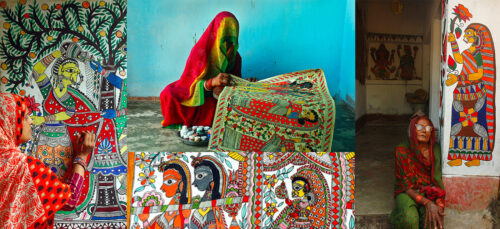
Techniques and Strokes: Patterns and Precision
Madhubani Art is famous for its distinctive patterns and precision. Artists employ various techniques, such as Bharni, Kachni, Tantrik, and Godna, each having its distinct characteristic and significance. It’s important to note that the process can vary slightly based on the individual artist’s style, regional influences, and the type of Madhubani art they practice. Some artists may also incorporate unique techniques or experiment with different materials while staying true to the essence of this traditional art form.
patterns and motifs
Three walls of houses are typically adorned in home murals:
- Gosai Ghar or Family Deity Room: This is a room dedicated to the family deity.
- Kohbar Ghar or Newlyweds’ Room: A room for newlywed couples.
- Baraamda outside Kohbar Ghar: Used as a room for guests, serving as a waiting area.
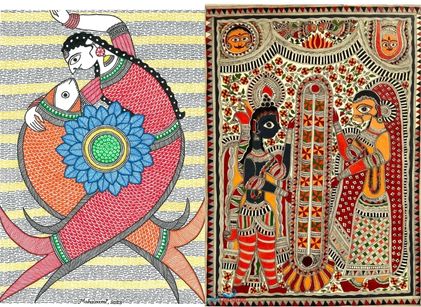
In Madhubani paintings, some important symbols are:
- Parijat Tree – Symbol of fertility and abundance.
- Two Peacocks – Symbol of eternity.
- Elephant with Trunk Raised – Symbol of successful pregnancy.
- Lotus – Symbol of sexual energy.
- Circular Motif – Symbol of the gods of creation.
- Parrot – Symbol of love and fidelity.
- Snake – Symbol of the power of rebirth.
- Mandala – Used to evoke love between newlyweds.
These murals are traditional elements of Madhubani art and carry cultural and symbolic significance within the household.

Colors are governed by the five basic elements of life – Earth, Water, Fire, Air, and Ether. These are represented by various colors: yellow signifies Earth, white signifies Water, red signifies Fire, blue signifies Sky, and black signifies Air. These elements are also understood through three fundamental shapes – triangle, circle, and square.
A triangle with its apex pointing upwards represents Fire, while the one with its apex downwards symbolizes Water. The square represents Earth. The circumference of a circle represents Air, while its inner part signifies Ether (Sky). Ether and Air, Fire and Water are interconnected. All these forms emerge from a single point, representing the embodiment of Shiva and Shakti. A mixed point is formed when the formless Shiva envisions itself in the form of Shakti.
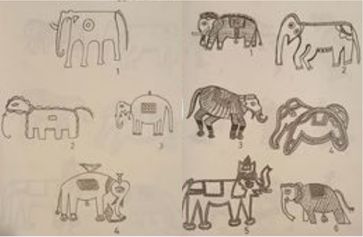
The art form has many kinds of motifs/morals and shapes and they have so many varieties in drawing techniques of every motif. Every artist has their own style to draw them:

Broadly depicted subjects and designs include Hindu deities such as Krishna, Rama, Shiva, Durga, Lakshmi, Saraswati, Surya, and Chandra, Tulsi plant, scenes from courts, wedding scenes, social events, etc. To Fill all intervals use Floral, animal, and bird motifs, geometric designs.
Contemporary Adaptations: Madhubani Art in Modern Times
Madhubani in Fashion- From Runways to Ramps :The mesmerizing patterns and colors of Madhubani Art have made their way into the fashion industry. Renowned fashion designers have incorporated these designs into their collections, bringing this traditional art form to a global audience.
Madhubani in Interior Décor- Artistic Elegance at Home : The intricacies of Madhubani Art have found their place in modern interior décor. From wall hangings to cushions, this art form adds a touch of artistic elegance to contemporary living spaces.
Madhubani Art in Global Art Scene: A Worldly Perspective
Madhubani Art has transcended geographical boundaries and has earned recognition on the global art scene. Its unique style and cultural significance have made it a cherished art form worldwide. Over the years, it has gained recognition and appreciation on the global art scene. Let’s explore some important events that have contributed to its rise in prominence:
Origin and Early Development:
This has a long history, dating back to ancient times. Women predominantly practiced the art form, using natural pigments and brushes to create intricate and colorful paintings on the walls and floors of their homes to celebrate festivals, weddings, and other auspicious occasions.
Recognition by William G. Archer:
In the 1930s, a British colonial officer named William G. Archer noticed the unique art form during a survey of the region. He admired its distinctive style and encouraged local artists to preserve their work for a wider audience by painting on paper instead of walls.
Exhibition in India and Abroad:
In the 1960s and 1970s, the art form gained attention through various exhibitions held within India and later in countries like Japan, the United States, and Europe. These exhibitions introduced the art form to a global audience and garnered interest from collectors, art enthusiasts, and scholars.
Recognition as a Form of Indian Art:
In 1969, the Government of India recognized Madhubani art as a distinct and important art form, which further bolstered its reputation and encouraged artists to continue preserving and promoting their traditional techniques.
Geographical Indication (GI) Tag:
In 2018, Madhubani art was granted the Geographical Indication (GI) tag, which officially recognized it as a traditional art form originating from the Mithila region of Bihar, India. The GI tag provides legal protection to the art form and prevents its imitation or misuse.
Promotion by NGOs and Government Initiatives:
Several non-governmental organizations (NGOs) and government initiatives have been instrumental in promoting and preserving Madhubani art. They have provided training, workshops, and platforms for artists to showcase their work both nationally and internationally.
Contemporary Adaptations:
As the art form gained popularity, some artists began to adapt the traditional style to create contemporary Madhubani paintings. This fusion of traditional elements with modern themes attracted a wider audience and diversified the appeal of Madhubani art.
Artists’ Participation in International Art Festivals:
Many Madhubani artists have represented India in various international art festivals and events. Their participation has not only raised awareness about the art form but also established its position in the global art community.
Art Galleries and Museums:
Over time, Madhubani art found its way into renowned art galleries and museums across the world. Such prestigious institutions have further validated its significance as an important cultural art form by displaying it.
Online Platforms and Social Media:
With the advent of the internet and social media, Madhubani artists have gained wider exposure and opportunities to reach global audiences. Online platforms have played a crucial role in promoting and selling their artwork internationally.
Please note that the art world is dynamic and constantly evolving. New events and developments may have occurred since my last update. We recommend conducting further research to get the most up-to-date information on Madhubani art’s status in the global art scene.
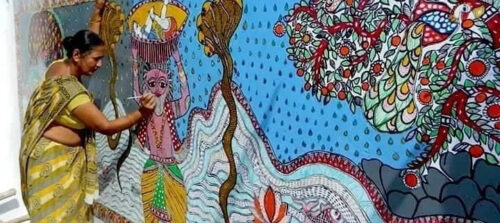
Preserving and Promoting Madhubani Art
Government Initiatives and Support : The Indian government, recognizing the cultural significance of Madhubani Art, has taken several initiatives to preserve and promote this traditional art form. Art workshops, exhibitions, and financial assistance to artists have helped in sustaining this invaluable heritage.
Art Galleries and Museums-Showcasing Cultural Heritage: Several art galleries and museums around the world have dedicated spaces to exhibit Madhubani Art. These platforms not only provide exposure to the artists but also create awareness about the art form among diverse audiences.
Artisan Cooperatives- Empowerment through Unity : Artisan cooperatives have formed to support and promote the interests of Madhubani artists. By working together, artists can access better opportunities, fair prices for their work, and maintain the integrity of their cultural heritage.
Top madhubani artists
The art has a plethora of talented artists, and it is difficult to single out just a few as the “best” since each artist brings their unique style and creativity to the art form. However, some artists have gained significant recognition for their contributions to Madhubani art and have played instrumental roles in promoting and preserving the tradition. Here are some notable Madhubani artists:
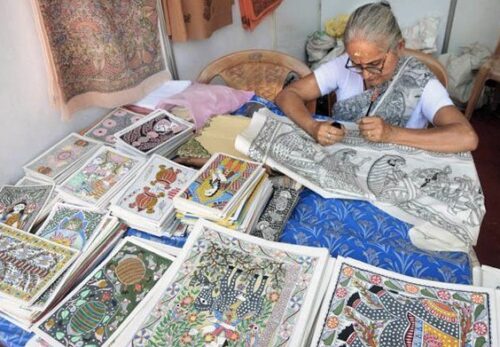
Sita Devi (1914-2005):
Considered one of the pioneers of Madhubani art. Sita Devi’s work gained international recognition when she received the Padma Shri, one of India’s highest civilian awards, in 1981. Her paintings beautifully depicted scenes from Hindu mythology and local folktales.
Ganga Devi (1928-1991):
Another influential artist, Ganga Devi, contributed to the modernization of Madhubani art. She experimented with different styles and themes while maintaining the essence of the traditional art form. Her works have been exhibited globally and earned her several prestigious awards.
Bharti Dayal:
Bharti Dayal is a well-known Madhubani artist who has expanded the boundaries of the art form by incorporating contemporary themes and subjects into her paintings. Her work reflects a blend of tradition and modernity.
Baua Devi:
Baua Devi is celebrated for her remarkable skill in portraying animals and birds in Madhubani art. Her intricate and lively depictions of nature have won her acclaim and appreciation.
Mahasundari Devi (1926-2013):
Mahasundari Devi was renowned for her exceptional storytelling through Madhubani art. Her paintings often depicted scenes from religious epics and mythological tales.
Pushpa Kumari:
Pushpa Kumari is a talented Madhubani artist known for her mastery of Kachni style, with an emphasis on intricate detailing and fine lines in her paintings.
Bharti Karn:
Bharti Karn’s work stands out for its contemporary relevance and socio-cultural themes. She is known for promoting Madhubani art through various workshops and exhibitions.
Manisha Jha:
Manisha Jha is recognized for her innovative approach to Madhubani art, blending traditional elements with modern concepts, and infusing her work with vibrant colors.
carier opportunity in this Art field
Yes, there are career opportunities in the field of Madhubani art for talented artists and individuals with a passion for this traditional art form. While Madhubani art has deep roots in the cultural and artistic heritage of the Mithila region, it has also evolved to adapt to modern times, creating avenues for artists to pursue various career paths. Some career opportunities in the field of Madhubani art include:
Professional Artist:
Talented Madhubani artists can establish themselves as professional artists, creating and selling their paintings through galleries, exhibitions, and online platforms. They can also participate in art fairs and cultural events to showcase and promote their work.
Art Teacher/Trainer:
Experienced artists can become art teachers or trainers, passing on their knowledge and skills to aspiring artists. They can conduct workshops, art classes, or even work with schools and organizations to promote the art form.
Art Conservationist/Restorer:
Conservation is an essential aspect of preserving this traditional art form. Individuals with expertise in art conservation and restoration can work in museums, cultural institutions, or private collections to conserve and restore Madhubani artworks.
Art Consultant/Curator:
Art consultants and curators can work with galleries, museums, or private collectors to advise on Madhubani art collections, organize exhibitions, and curate art shows related to Madhubani and other traditional art forms.
Design and Fashion:
Madhubani motifs and patterns can be incorporated into fashion and product design, creating unique and culturally-rich products like clothing, accessories, home decor, and more.
Art Entrepreneurship:
Entrepreneurs can establish art studios, galleries, or online platforms that exclusively promote and sell Madhubani art. They can also collaborate with artists to create innovative products or commission art for various projects.
Art Therapy:
Madhubani art can be utilized as a form of art therapy, promoting mental and emotional well-being. Art therapists can use this art form to work with individuals or communities facing various challenges or seeking personal growth.
Cultural Promoter:
Individuals passionate about preserving and promoting traditional art and culture, including Madhubani art, can work with cultural organizations, NGOs, or government bodies to organize events, workshops, and initiatives aimed at spreading awareness and appreciation for the art form.
It’s important to note that like any creative field, establishing a career in Madhubani art may require dedication, networking, and continuous effort. However, the rich cultural heritage and growing global interest in traditional art forms provide opportunities for passionate individuals to make a meaningful and rewarding career in the realm of Madhubani art.
Government Certification courses in Madhubani Art
Many Government certification course are available for the art that one can opt out. UMSAS-Certificate Course Madhubani Art Painting by Government of Bihar is one of them. For the Current Information for Certificate Course, Mithila Painting Institute, Madhubani click here.
Another option that can be choosen is National Institute Of Mithila Art located at Bihar, India. It is also World’s First Professional Mithila Art Online – Offline 6 months certification Course. Mithila School of Art located at Patana, India can be consider as well. They provide Diploma Programme for the Art and also detailed learning about its various forms.
Similaraly some Institution also provides certification for this art like; Areawala Online Madhubani Painting Class, Footwear Design & Development Institute (FDDI), Patna campus has started a training center for Madhubani Painting on Hard Goods items at Siswar village in the district of Madhubani, Bihar. Another Online classes at Kavi Art Studio Hydarbad, Telangana, India.
Above are the first choosen options. Besides of above there are many private tution websites social media profies and pages are there, who make learn this Art offline and online.
earning by this art form
The earning potential in the field of Madhubani art can vary significantly based on several factors, including the artist’s skill level, recognition, demand for their work, and the market they target. Here are some factors that can influence how much one can earn through Madhubani art:
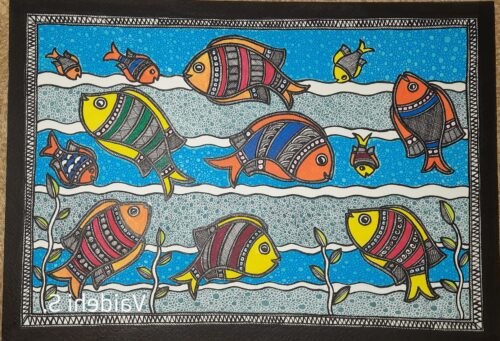
Skill and Expertise:
Highly skilled and experienced Madhubani artists, especially those who have mastered intricate techniques and unique styles, often have the potential to command higher prices for their artworks.
Recognition and Awards:
Artists who have gained recognition through awards, honors, or participation in prestigious exhibitions and art events may attract more buyers and collectors, leading to increased earnings.
Market Demand:
The demand for Madhubani art can vary depending on trends, cultural events, and the interest of collectors and art enthusiasts. During peak times or festivals, the demand for Madhubani paintings may surge, allowing artists to earn more.
Artistic Themes and Size:
The subject matter and size of the artwork can also impact its value. Larger, more intricate pieces or those featuring popular themes may be priced higher.
Art Sales and Commissions:
Artists who actively sell their work through galleries, art fairs, exhibitions, and online platforms may have more opportunities to generate income from sales and commissions.
Teaching and Workshops:
Artists who conduct workshops or offer art classes can earn additional income by sharing their knowledge and skills with aspiring artists or art enthusiasts.
Licensing and Merchandising:
Some artists may explore licensing their artwork for commercial purposes, such as in fashion, home decor, or other products, which can provide another source of income.
Furthermore, the cost of living and prevailing market conditions in different regions can also impact an artist’s earnings. As with any artistic career, success in Madhubani art often requires dedication, continuous improvement of skills, effective marketing, and perseverance to establish a steady income.
The earnings of a Madhubani artist can vary significantly, and it’s challenging to provide precise figures due to the numerous factors influencing income in this field. However, we can give you a general idea of the income range based on the different levels of recognition and demand:
Starting/Local Artists:
Artists who are just starting in the field or have limited recognition may earn anywhere from $100 to $500 per artwork, depending on the size, complexity, and local market demand.
Mid-level Artists:
As an artist gains more experience and recognition, their earnings may increase to the range of $500 to $2,000 per artwork. Mid-level artists might have a more consistent stream of sales and opportunities for workshops.
Established Artists:
Established Madhubani artists with significant recognition, awards, and exhibitions can earn $2,000 to $10,000 or more per artwork. Their artwork may be sought after by collectors and art enthusiasts, allowing them to command higher prices.
Renowned Artists:
Internationally renowned Madhubani artists may earn even higher amounts, with some of their works fetching tens of thousands of dollars or more at auctions and high-profile art events.
It’s essential to remember that these figures are general estimates, and individual earnings can vary. Additionally, artists may have multiple income streams, including teaching, commissions, art sales, and licensing, which can contribute to their overall earnings.
Conclusion
Madhubani Art is more than just a form of expression; it is a celebration of cultural heritage and identity. With its vibrant colors, intricate patterns, and timeless narratives, Madhubani Art continues to leave an indelible mark on the global art scene. As we cherish this unique art form, let us ensure its preservation for generations to come.
FAQs
- Is Madhubani Art limited to traditional themes only?
No, while Madhubani Art is rooted in traditional themes, contemporary artists have adapted it to represent modern ideas and concepts. - Can anyone learn Madhubani Art?
Yes, Madhubani Art is open to all, and with dedication and practice, anyone can learn and master this unique art form. - What makes Madhubani Art eco-friendly?
The use of natural pigments and eco-friendly materials in creating Madhubani Art makes it an environmentally sustainable practice. - Is Madhubani Art only restricted to Bihar, India?
While it originated in Bihar, Madhubani Art has gained international recognition and is practiced by artists across the globe. - Can Madhubani Art be used as a form of therapy?
Yes, engaging in Madhubani Art can be therapeutic and meditative, promoting mindfulness and creativity.
Found it helpful ? …. Explore More on…. Folk Art @guisegarner

